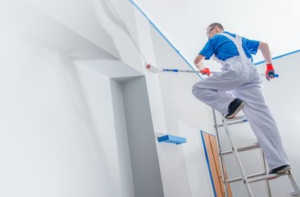Residential painting involves much more than just a fresh coat of paint. A quality job requires careful planning and execution, resulting in the best-looking outcomes at an optimal price.
The best way to do that is to work with experienced house painters with the skills, tools, and knowledge to produce flawless results. Click here to Learn More.

Often overlooked, the ceilings of our rooms can communicate a lot about our design style and mood. Adding a fresh coat of paint to a room’s ceiling is an easy way to refresh the entire space without a major renovation project. But painting the ceiling can also be a bit of a pain in the neck—literally.
To make the job easier, Vaamonde recommends removing any light fixtures that are too cumbersome to move, and covering anything that can’t be moved with drop cloths. She also recommends taking the opportunity to clean the room’s ceiling, and if you can, removing any smoke detectors or other items that hang from the ceiling. Finally, you’ll want to mask the edges of the walls and crown molding with quick-release painter’s tape.
When it comes to the actual painting, work in sections of about 5 or 6 ft. square, to avoid dripping paint or leaving lap marks. Start your first section by overlapping onto the wet edge of the last one to help keep you from accidentally painting over something you don’t intend to.
A high-quality, latex ceiling primer will help provide a smooth surface for your paint, and cover any stains or discolorations. It’s a good idea to apply the primer using a brush, rather than a roller, to ensure a neat, even application.
Finally, for the main event, you’ll need a high-quality, waterborne ceiling paint that dries quickly and hides imperfections well. A “dead flat” paint works best for this purpose, and Benjamin Moore offers thousands of shades to choose from, so you’re sure to find the perfect color for your ceiling.
Whether you’re updating your entire home or just one room, professional interior painting can add value to your property and make your living spaces look newer and more appealing. So if you’re ready to breathe some life into your home, contact a local pro for free, no-commitment quotes. They’ll be happy to give you expert advice on the best colors for your space and how to tackle those hard-to-reach spots. They’ll also help you choose the right equipment to get the job done.
Bathrooms are often the first areas of the house to show signs of wear. They can also be one of the most challenging rooms to paint. Because of the high humidity levels in bathrooms, painted surfaces can quickly become mildewy or moldy. It is important that the right paint is used in this room to prevent these problems. Choosing a moisture resistant paint with an anti-fungal agent will help.
As with all painting projects, preparation is key for success. Before beginning, it is best to remove any light fixtures or hardware from the walls. This includes the removal of the mirror and any hardware that is attached to the vanity cabinet. Next, cover any items that you do not want to be painted with plastic sheeting and spread a drop cloth on the floor in case of any accidental drips.
Once the prep is done, you can begin painting. Be sure to use a sash brush to get into the corners of the room. The bristles on a sash brush are tapered and can reach into small spaces that other brushes cannot. It is a good idea to choose a white or beige paint for the bathroom, as it will reflect the sunlight and make the room look larger. Lastly, consider adding an oversized mirror to the wall to magnify the existing natural light and make the room appear more spacious.
Residential painting is a large job and should be undertaken by professionals who have the tools, skills, and knowledge to perform the task in a safe and efficient manner. The best way to find a residential painter is to do your research and take the time to compare quotes from different companies. It is important to find a company that has experience and is reliable and honest. Do not be swayed by a low price alone, as the quality of the finished product will be more than worth the extra investment. Choosing the right company can transform your home and boost its curb appeal for years to come. Whether you are looking to have your home’s interior or exterior painted, there is a residential painting company that can help you achieve the look you have always wanted.
There are many daunting tasks a homeowner may attempt to do around the house, from landscaping and retiling a tub, but few DIY jobs make as much of an impact in such little time as repainting. A fresh coat of paint can transform a bedroom from a boring space into a cozy retreat. If your bedroom is in need of a facelift, it’s worth the time and effort to make it happen.
Bedrooms are low-impact areas where homeowners often use more neutral, muted color options that help promote a restful sleep environment. Vibrant yellows and reds are best reserved for living rooms, but they’re not conducive to a calm space where you prepare for bedtime. Instead, look for paints with soft greens and blues to create a relaxing escape.
Choosing the right paint sheen is important, as well. While shiny sheens like gloss or semigloss aren’t recommended for bedrooms, satin and eggshell paints offer a more durable option that can easily be wiped clean of any marks or smudges.
The key to a successful painting project is having all of the necessary tools. A high-quality brush is important to help you get into tight corners and crevices. A roller can also be a valuable tool for large surfaces, as it allows you to cover a large area in a short amount of time. Tape is another must-have for residential painting, as it helps you achieve a flawless finish on all edges and surfaces.
When it comes to a clean, crisp white wall color for bedrooms, no other choice is better than All White by Farrow and Ball. It’s a clean and classic white that can be accented with any interior decor color to suit your personal style.
The most popular wall colors for bedrooms are whites and grays, such as the classic Linen White OC-17 by Benjamin Moore. This popular white has warm undertones that are calming and inviting, making it an ideal choice for the master bedroom. For a bolder alternative, try a peach or blush tone, like the blush pink in this client’s bedroom, to add warmth and whimsy.
Homeowners tend to have a specific vision for the visual appeal of their spaces. Residential painters can work with homeowners to meet those goals, including by recommending colors and treating surfaces properly. They also have experience working with the complexities of different types of surfaces, and can help homeowners avoid painting mistakes like mismatched wall colors or paint drips.
Kitchens are especially hard-wearing areas, so it’s important to choose a durable paint. This ensures that the new finish stands up to repeated scrubbing and washing and will continue to look good for years to come. A high-quality kitchen paint will typically be formulated to be easy to wipe down and should be used on both walls and ceilings.
It’s a good idea to start at the top and work down so that any drips can be wiped away before they’re a problem. You can opt for a sprayed-on finish, which will give your kitchen an extra smooth and even surface. However, this is a time-consuming process and requires special equipment that can be costly to rent. It’s also essential to mask off any areas that shouldn’t get painted, such as the edges of the room or countertops.
A simple coat of paint can instantly brighten up a kitchen, making it feel bigger and lighter. Designer Meg Kelly chose a warm grey (Sherwin-Williams’ Tinsmith, SW 7657) for the cabinets in this East Nashville home, and a crisp white on the walls to keep things feeling light and airy.
Choosing a similar color for the ceiling can further open up the space and make it feel larger, as it does here in this modern farmhouse kitchen. Sherwin-Williams’ Classic White (SW 7003) keeps the palette feeling balanced and calm.
While neutrals are great for kitchens, you can use bolder shades to add interest and drama. Here, a mustard yellow wall in this kitchen makes the two substantial wall cabinets recede and accentuates the white window frame and ceramic sink.
Whether it’s in a business, an office building, or an apartment complex, commercial spaces require a lot of foot traffic. This can make it tricky to get a project done, as the property may have to remain open for customers or employees throughout the job.

